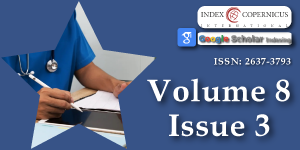Is Acupuncture Efficient for Treating Long COVID? Case Reports
Main Article Content
Abstract
Long COVID can be defined as a set of symptoms appearing more than 28 days after a documented acute COVID-19. Among them, extreme fatigue and troubles of moods are the most common. To verify that acupuncture can efficiently alleviate long COVID, a chronic disease partly escaping to other treatments, especially fatigue and troubles of mood. To collect data pertaining to the patients included in the study as described in the STROBE guideline. To diagnose the clinical conditions of the patients using the Nan jing in order to choose the meridian and the points to be toned or dispersed depending on the observation of tongue and pulse. Acupuncture can greatly improve the troubles of patients suffering from long COVID after a reduced number of sessions (1 to 4).
Article Details
Copyright (c) 2024 Lake D, et al.

This work is licensed under a Creative Commons Attribution-NonCommercial 4.0 International License.
Mendelson M, Nel J, Blumberg I, Madhi SA, Dryden M, Stevens W, et al. Long-Covid: an evolving problem with an extensive impact. S. Afr. Med. J. 2020;111:10-12. Available from: https://doi.org/10.7196/samj.2020.v111i11.15433
Nabavi N. Long Covid: how to define it and how to manage it. BMJ. 2020;370. Available from: https://doi.org/10.1136/bmj.m3489
Alwan NA, Johnson L. Defining long COVID: going back to the start. Med. (NY). 2021;2:501-504. Available from: https://doi.org/10.1016/j.medj.2021.03.003
Carfi A, Bernabei R, Landi F. Persistent symptoms in patients after acute COVID-19. JAMA. 2020;324:603-605. Available from: https://doi.org/10.1001/jama.2020.12603
Puntmann VO, Carerj ML, Wieters I, Fahim M, Arendt C, Hoffmann J, et al. Outcomes of cardiovascular magnetic resonance imaging in patients recently recovered from coronavirus disease 2019 (COVID-19). JAMA Cardiol. 2020;5:1265-1273. Available from: https://doi.org/10.1001/jamacardio.2020.3557
Chamberlain SR, Grant JE, Trender W, Hellyer P, Hampshire A. Post-traumatic stress disorder symptoms in COVID-19 survivors: online population survey. B. J. Psych. Open. 2021;9. Available from: https://doi.org/10.1192/bjo.2021.3
Nalbandian A, Sehgal K, Gupta A, Madhavan MV, McGroder C, Stevens JS, et al. Post-acute COVID-19 syndrome. Nature Med. 2021;27:601-615. Available from: https://doi.org/10.1038/s41591-021-01283-z
Yelin D, Margalit I, Yahav D, Runold M, Bruchfeld J. Long COVID-19 — it’s not over until? Clin. Microbiol. Infect. 2021;27:506-508. Available from: https://doi.org/10.1016/j.cmi.2020.12.001
Barker-Davies RM, O’Sullivan O, Senaratne KPP, Baker P, Cranley M, Dharm-Datta S, et al. The Stanford Hall consensus statement for post-COVID-19 rehabilitation. Br. J. Sports Med. 2020;54:949-959. Available from: https://doi.org/10.1136/bjsports-2020-102596
Hoffmann M, Kleine-Weber H, Schroeder S, Krüger N, Herrler T, Erichsen S, Schiergens TS, et al. SARS-CoV-2 cell entry depends on ACE2 and TMPRSS2 and is blocked by a clinically proven protease inhibitor. Cell. 2020;181:271–280. Available from: https://doi.org/10.1016/j.cell.2020.02.052
Moreno-Pérez O, Merino E, Leon-Ramirez J-M, Andres M, Ramos JM, Arenas-Jiménez J, Asensio S, Sanchez R, et al. Gil J, COVID19-ALC research group. J. Infect. 2021;82:378-383. Available from: https://doi.org/10.1016/j.jinf.2021.01.004
Fernández-de-las-Peñas C, Palacios-Ceña D, Gómez-Mayordomo V, Cuadrado ML, Florencio LL. Defining post-covid symptoms (Post-acute COVID, long COVID, Persistent post-COVID): an integrative classification. Int. J. Environ. Res. Public Health. 2021;18:2621. Available from: https://doi.org/10.3390/ijerph18052621
Greenhalgh T, Knight M, A’Court C, Buxton M, Husain L. Management of post-acute COVID-19 in primary care. BMJ. 2020;370:3026. Available from: https://doi.org/10.1136/bmj.m3026





